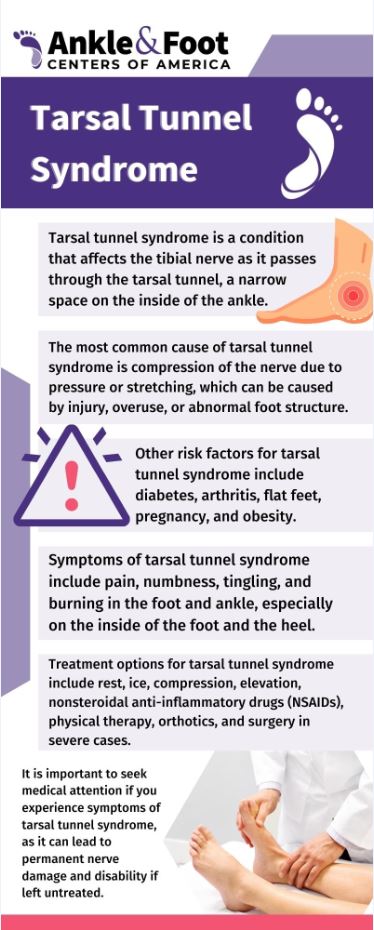Tarsal tunnel syndrome is a condition that affects the tibial nerve in the ankle. The tibial nerve runs along the back of the ankle, through a narrow passage called the tarsal tunnel. When this nerve is compressed or damaged, it can lead to a range of symptoms including pain, numbness, and tingling in the foot or ankle area. In this article, we will explore eight important things you need to know about tarsal tunnel syndrome.
Symptoms of Tarsal Tunnel Syndrome
 One of the most common symptoms of tarsal tunnel syndrome is pain in the foot or ankle area. This pain can range from a dull ache to a sharp, shooting sensation. Many people feel these symptoms more severely when standing or walking. Other symptoms of tarsal tunnel syndrome include numbness or tingling in the foot or ankle, and a feeling of weakness in the affected area.
One of the most common symptoms of tarsal tunnel syndrome is pain in the foot or ankle area. This pain can range from a dull ache to a sharp, shooting sensation. Many people feel these symptoms more severely when standing or walking. Other symptoms of tarsal tunnel syndrome include numbness or tingling in the foot or ankle, and a feeling of weakness in the affected area.
Causes of Tarsal Tunnel Syndrome
There are many factors that can contribute to the development of tarsal tunnel syndrome. Trauma to the ankle or foot, such as a sprain or fracture, can cause swelling and inflammation in the area, which can put pressure on the tibial nerve. Other risk factors include having flat feet, varicose veins, or systemic diseases such as diabetes.
Diagnosis of Tarsal Tunnel Syndrome
To accurately diagnose tarsal tunnel syndrome, it is important to see a podiatrist or other medical professional who specializes in foot and ankle health. The podiatrist will perform a physical examination of the affected area and may order imaging tests such as X-rays, MRIs, or nerve conduction studies. These tests can help to confirm the diagnosis and determine the severity of the condition.

Treatment of Tarsal Tunnel Syndrome
There are a variety of Tarsal Tunnel Syndrome treatment options available for tarsal tunnel syndrome, depending on the severity of the condition. Treatment may include rest, ice packs, anti-inflammatory medication, physical therapy, custom orthotics, and possibly surgery if deemed necessary by your physician. It is important to work closely with your healthcare provider to determine the best treatment plan for your individual needs.
Prevention of Tarsal Tunnel Syndrome
The best way to prevent tarsal tunnel syndrome from developing is to take good care of your feet and ankles. This includes wearing properly fitted shoes, maintaining a healthy weight, and exercising regularly, with a focus on stretching exercises that target the lower legs. By taking these preventive measures, you can reduce your risk of developing tarsal tunnel syndrome.
Risk Factors for Tarsal Tunnel Syndrome
Certain factors can increase your risk of developing tarsal tunnel syndrome. These include being overweight, pregnant, or having flat feet or other foot or ankle conditions. It is important to be aware of these risk factors and to take steps to reduce your risk of developing tarsal tunnel syndrome.
If left untreated, tarsal tunnel syndrome can lead to chronic pain and permanent nerve damage. It is important to seek medical attention as soon as possible if you suspect that you may be suffering from this condition. With proper diagnosis and treatment, it is possible to prevent further complications and improve your overall quality of life.
Tarsal Tunnel Syndrome Surgery and Recovery
 Fortunately, there are surgical treatments available that can relieve symptoms and improve mobility. Surgery for tarsal tunnel syndrome involves releasing pressure on the nerve by cutting through ligaments and other soft tissue along with removing any cysts or tumors compressing it. In some cases, surgeons may need to perform an open procedure where they make an incision over the affected area. Other times endoscopic surgery may be used which requires only small incisions around the ankle area while allowing doctors to work inside using a special camera tool called an arthroscope. Recovery time after surgery depends on how extensive it was but typically takes several weeks before full movement is restored and any residual pain has subsided completely.
Fortunately, there are surgical treatments available that can relieve symptoms and improve mobility. Surgery for tarsal tunnel syndrome involves releasing pressure on the nerve by cutting through ligaments and other soft tissue along with removing any cysts or tumors compressing it. In some cases, surgeons may need to perform an open procedure where they make an incision over the affected area. Other times endoscopic surgery may be used which requires only small incisions around the ankle area while allowing doctors to work inside using a special camera tool called an arthroscope. Recovery time after surgery depends on how extensive it was but typically takes several weeks before full movement is restored and any residual pain has subsided completely.
The Importance of Seeing a Podiatrist
If you suspect that you may be suffering from tarsal tunnel syndrome, it is important to see a podiatrist for an accurate diagnosis and treatment plan. Podiatrists are specialists in the foot and ankle area, and they are trained to diagnose and treat a wide range of issues including tarsal tunnel syndrome. By working with a podiatrist, you can get the care and treatment you need to manage your symptoms and improve your overall quality of life.
Managing Tarsal Tunnel Syndrome
 For people living with tarsal tunnel syndrome, there are several steps that can be taken to manage the condition and reduce symptoms. Strengthening the muscles in the lower legs through exercises such as calf raises, ankle stretches, and toe extensions can help to improve flexibility and relieve pain. It is also important to avoid activities that strain the affected area, and to use orthotics or custom insoles to provide additional support and cushioning for the feet when standing or walking.
For people living with tarsal tunnel syndrome, there are several steps that can be taken to manage the condition and reduce symptoms. Strengthening the muscles in the lower legs through exercises such as calf raises, ankle stretches, and toe extensions can help to improve flexibility and relieve pain. It is also important to avoid activities that strain the affected area, and to use orthotics or custom insoles to provide additional support and cushioning for the feet when standing or walking.
In conclusion, tarsal tunnel syndrome is a condition that can cause significant pain and discomfort in the foot and ankle area. It is important to be aware of the symptoms and risk factors associated with this condition, and to seek medical attention as soon as possible if you suspect that you may be suffering from it. By working with a podiatrist to get an accurate diagnosis and treatment plan, and by taking steps to prevent and manage the condition, it is possible to live a life free from pain and discomfort caused by tarsal tunnel syndrome.



